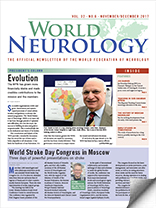Highlights of the ninth neurology training course
By Wolfgang Grisold
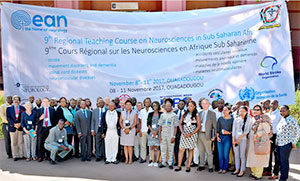
This is a report from the Ninth Regional Teaching Course in Sub-Saharan Africa, organized by the European Academy of Neurology (EAN) and EAN Task Force, under the leadership of Prof. Schmutzhard and Eveline Sipido. The local organizer was Prof. Jean Kabore.
The Ninth Regional Teaching Course in Sub-Saharan Africa took place Nov. 8-11 in Ouagadougou, Burkina Faso. The EAN Regional Teaching Course was co-sponsored by the African Academy of Neurology, Le Burkine Faso Society of Neurology, the American Academy of Neurology (AAN), the International Brain Research Organization (IBRO), the International Parkinson and Movement Disorders Society, The World Stroke Organization, and the World Federation of Neurology.
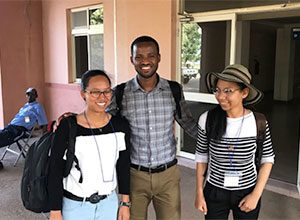
Three successful and knowledgeable residents: (left to right) Nomena Finiavana Rasaholiarison, Madagascar; Girma Diltata Muzie, Ethiopia; and Ratsitohara Santatra Razafindrasata, Madagascar.
The aim of this Regional Teaching Course is fostering neurology training in Sub-Saharan Africa. The topics were determined by the faculty and also by residents of the last meeting that took place in 2016. The format of the course contained plenary lectures, new highlights, clinical grand rounds, and afternoon interactive case discussions with the faculty. An examination tested the knowledge of the participants. The success rate of the participants at this course was 85 percent.
Teaching Course Topics
On Day 1, the topic of stroke in Sub-Saharan Africa was discussed. The session was opened by Prof. Schmutzhard and Prof. Kabore. Also, the director of the faculty of medical sciences and the dean of the university participated. Reviews of basic principles of epidemiology, clinical presentations, and the state-of-art in diagnostic work-up and therapeutic management were discussed. Prof. Yomi Ogun, president of AFAN, gave an outline on diagnostic and therapeutic management in urban and rural Sub-Saharan Africa.
Following this, in the clinical grand rounds, patients were presented and discussed by the audience. The interactive clinical case discussions consisted of four groups (stroke, movement disorders, spinal cord, and muscle diseases) which were changed every day. Each day, every group had the opportunity to discuss these subtopics with the faculty.
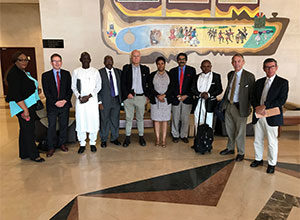
The faculty of the EAN teaching course in Burkina Faso.]
On Day 2, the topic of Movement Disorders and Dementia in Sub-Saharan Africa was discussed. Following the talk on Epidemiology and Classification, the presenter from the AAN, Prof. Reilly, gave a talk on clinical presentations and diagnostic work-up. Prof. Rac Kalaria from Kenya/U.K. gave a comprehensive review on the clinical presentations, diagnostic work-up, and therapeutic management in dementia. There were also grand rounds and interactive case discussions.
On Day 3, the topic of Spinal Cord Diseases in Sub-Saharan Africa was discussed. This was an interactive session. Epidemiology and classification, clinical presentation, signs and symptoms, diagnostic work-up and therapeutic management were discussed. The following grand rounds were controversial, and many different opinions from the audience, faculty and investigators had to be discussed.
On Day 4, the course on Neuromuscular Diseases in Sub-Saharan Africa was given. It was clearly pointed out by Prof. Kabore that epidemiology in Africa is lacking in Africa, and the few available epidemiology studies come from North or South Africa. W. Grisold talked on the clinical presentations, signs, and symptoms of neuromuscular disease, and Prof. J.M. Vallat from France gave a good overview in the diagnostic work-up, therapeutic management, and electrophysiological examples. Also, this course was followed by clinical grand rounds that showed the increased spectrum of discussed cases. The interaction between the faculty and the participants was very good.
A social program was used for interaction and networking. On Thursday, there was a joint reception, and on Friday, there was a final joint dinner. This dinner will be memorable, as all representatives from participating countries gave a short statement about their home countries and particularly medical services and neurological possibilities. These talks provided a view of the spectrum of the personalities of young neurologists in Sub-Saharan Africa.
The meeting closed on Saturday after the last interactive session with a farewell of the faculty and a farewell speech from all participating societies.
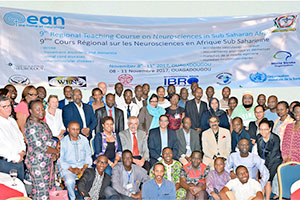
|
|||
| The 75 participants came from 18 countries: | |||
|
• Burkina Faso • Burundi • Cameroon • Congo Brazzaville |
• Congo Demo- cratic Republic • Ethiopia • Ghana • Guinea |
• Ivory Coast • Madagascar • Mozambique • Niger • Nigeria |
• Senegal • Sudan • Tanzania • Togo • Uganda |
